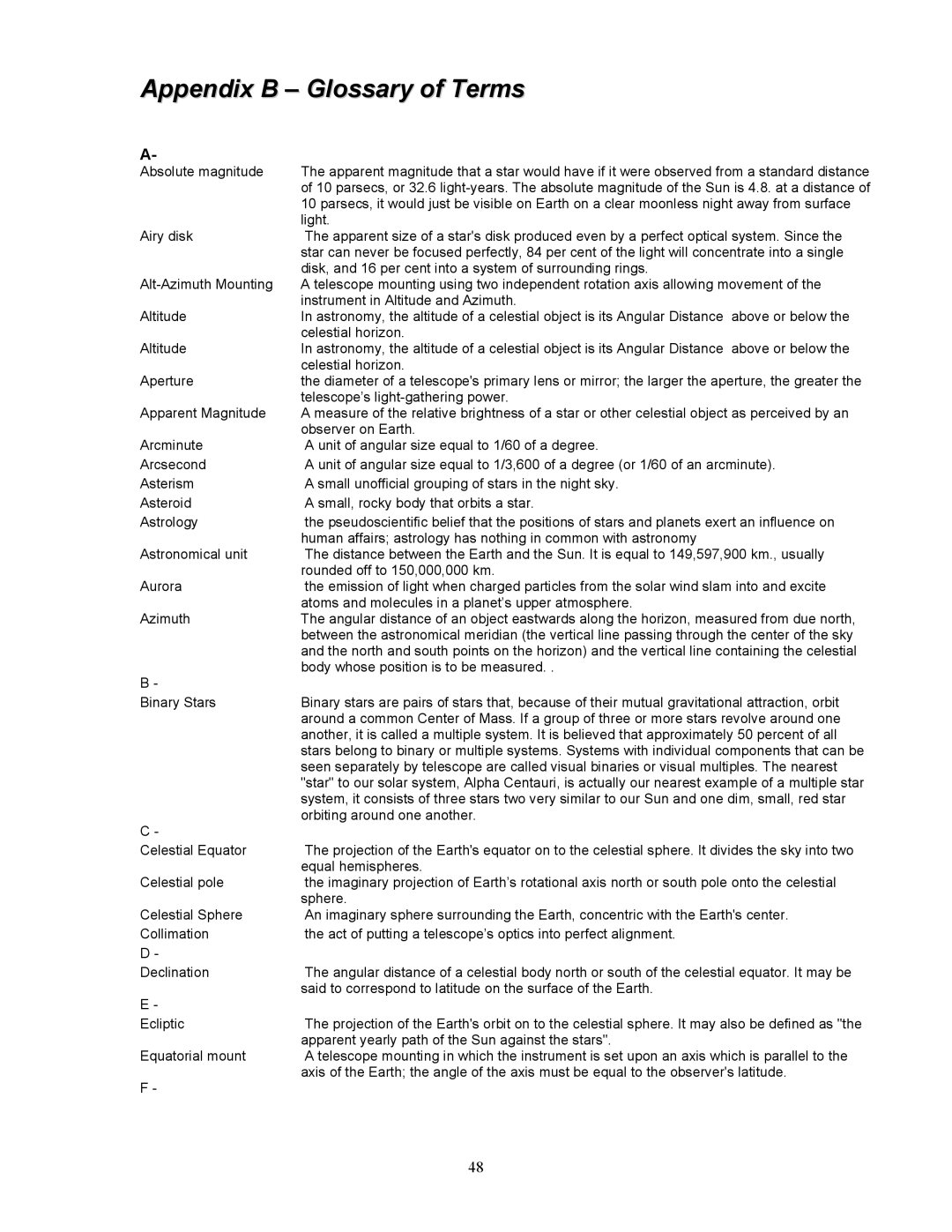Appendix B – Glossary of Terms
A-
Absolute magnitude | The apparent magnitude that a star would have if it were observed from a standard distance | |
| of 10 parsecs, or 32.6 | |
| 10 parsecs, it would just be visible on Earth on a clear moonless night away from surface | |
| light. |
|
Airy disk | The apparent size of a star's disk produced even by a perfect optical system. Since the | |
| star can never be focused perfectly, 84 per cent of the light will concentrate into a single | |
| disk, and 16 per cent into a system of surrounding rings. |
|
A telescope mounting using two independent rotation axis allowing movement of the | ||
| instrument in Altitude and Azimuth. |
|
Altitude | In astronomy, the altitude of a celestial object is its Angular Distance | above or below the |
| celestial horizon. |
|
Altitude | In astronomy, the altitude of a celestial object is its Angular Distance | above or below the |
| celestial horizon. |
|
Aperture | the diameter of a telescope's primary lens or mirror; the larger the aperture, the greater the | |
| telescope’s |
|
Apparent Magnitude | A measure of the relative brightness of a star or other celestial object as perceived by an | |
| observer on Earth. |
|
Arcminute | A unit of angular size equal to 1/60 of a degree. |
|
Arcsecond | A unit of angular size equal to 1/3,600 of a degree (or 1/60 of an arcminute). | |
Asterism | A small unofficial grouping of stars in the night sky. |
|
Asteroid | A small, rocky body that orbits a star. |
|
Astrology | the pseudoscientific belief that the positions of stars and planets exert an influence on | |
| human affairs; astrology has nothing in common with astronomy |
|
Astronomical unit | The distance between the Earth and the Sun. It is equal to 149,597,900 km., usually | |
| rounded off to 150,000,000 km. |
|
Aurora | the emission of light when charged particles from the solar wind slam into and excite | |
| atoms and molecules in a planet’s upper atmosphere. |
|
Azimuth | The angular distance of an object eastwards along the horizon, measured from due north, | |
| between the astronomical meridian (the vertical line passing through the center of the sky | |
| and the north and south points on the horizon) and the vertical line containing the celestial | |
B - | body whose position is to be measured. . |
|
|
| |
Binary Stars | Binary stars are pairs of stars that, because of their mutual gravitational attraction, orbit | |
| around a common Center of Mass. If a group of three or more stars revolve around one | |
| another, it is called a multiple system. It is believed that approximately 50 percent of all | |
| stars belong to binary or multiple systems. Systems with individual components that can be | |
| seen separately by telescope are called visual binaries or visual multiples. The nearest | |
| "star" to our solar system, Alpha Centauri, is actually our nearest example of a multiple star | |
| system, it consists of three stars two very similar to our Sun and one dim, small, red star | |
C - | orbiting around one another. |
|
|
| |
Celestial Equator | The projection of the Earth's equator on to the celestial sphere. It divides the sky into two | |
| equal hemispheres. |
|
Celestial pole | the imaginary projection of Earth’s rotational axis north or south pole onto the celestial | |
| sphere. |
|
Celestial Sphere | An imaginary sphere surrounding the Earth, concentric with the Earth's center. | |
Collimation | the act of putting a telescope’s optics into perfect alignment. |
|
D - |
|
|
Declination | The angular distance of a celestial body north or south of the celestial equator. It may be | |
E - | said to correspond to latitude on the surface of the Earth. |
|
|
| |
Ecliptic | The projection of the Earth's orbit on to the celestial sphere. It may also be defined as "the | |
| apparent yearly path of the Sun against the stars". |
|
Equatorial mount | A telescope mounting in which the instrument is set upon an axis which is parallel to the | |
F - | axis of the Earth; the angle of the axis must be equal to the observer's latitude. | |
|
| |
48
